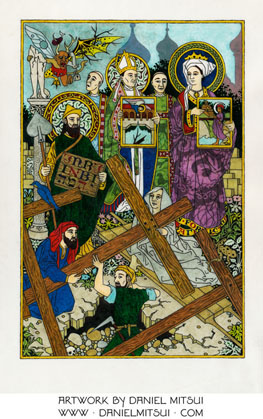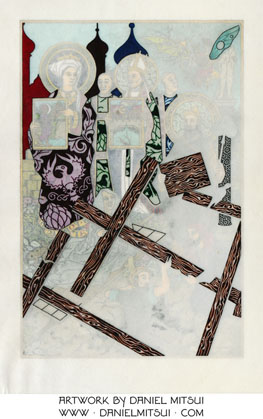
In the year AD 326, St. Helen, the mother of the emperor Constantine, travelled to Jerusalem to seek the True Cross. One of the scholars of the city knew its location: a hill upon which a temple dedicated to Venus had been built. This was a secret that had been passed down through his family since the time of the Passion. Helen had the temple razed and the ground excavated; there, three crosses were found. To distinguish the cross of Jesus Christ from the crosses of the two thieves, each was held over a corpse. The deceased came to life upon contact with the True Cross.
According to one account, the deceased was a leading woman of the city, whose body the bishop St. Macarius took to the site of the dig. St. Macarius stands near St. Helen in my drawing, accompanied by a deacon and a subdeacon.
According to St. Ambrose, the man who revealed the location of the True Cross discovered the titulus and professed his faith in Jesus Christ. The devil appeared when this happened and screamed his protest; I drew him clutching the remnants of a statue of Venus. I prefer the type of demon that was perfected in the art of Hieronymus Bosch. It is composed of disparate elements of men, animals, plants and inanimate objects, which communicates that evil is disordered and nonsensical.
The True Cross is the subject of a long legendary history. Although the stories it comprises are apocryphal and differ in their details, I believe that they are worthy of belief in general, or at the very least worthy of respect. According to one version of this history, the patriarch Seth approached the closed gates of Eden to beg for oil from the Tree of Mercy with which to anoint the body of his dying father Adam. The archangel instead gave him a branch from the Tree of the Knowledge of Good and Evil, which he planted over Adam’s grave. The bones of Adam (and presumably a branch of the tree, or its seed) were taken aboard the Ark by Shem, and later reburied by him and Melchizedek on Calvary.
The great tree that grew there was cut down by King Solomon for the construction of his forest house. The trunk of the tree, by a miracle, would not fit into any part of it, being always either too long or too short. It instead was thrown over a pond to serve as a bridge. When the Queen of Sheba visited King Solomon, she refused to walk on the trunk, prophesying that the Savior of the World would one day hang from it, and by his death bring the Kingdom of the Jews to an end. The Queen of Sheba was believed to suffer a horrible deformity of the feet; in art, her feet are represented as webbed goose feet or donkey hooves. Upon wading through the pond out of respect for the sacred wood, her deformity was healed.
King Solomon, struck with fear by her prophecy, had the trunk buried. The healing pool called Bethsaida welled up over it. Shortly before the Passion of Jesus Christ, the wood floated to the surface, and the True Cross fashioned from it.
In reference to this history, St. Macarius holds an icon of Bethsaida and St. Helen holds an icon of the Queen of Sheba’s cure.

I used the translucent calfskin for artistic effect, drawing certain details on the opposite side of the sheet, in reverse. These include the damask patterns, wood grain, and fossil coral in the stones. Like watermarks, these are more visible when the drawing is held up to a light. The original drawing thus has a different character depending on where and when it is seen.
The damask pattern is my own design. Explicitly religious pictures seem not to have been used commonly in medieval fabrics, perhaps because of the impropriety of cutting them. Here I have chosen images that are whimsical but suggestive of the overall subject of the picture. These include a barometz (a presumably mythical sheep that grows on a bush), a hooked catfish with a four-pronged fork in its back, and an eagle carrying a skull. A lamb lifted on a tree suggests the Crucified Christ; a fish is another symbol of Christ, here wounded five times; an eagle (representing empire) and a skull together suggest the discovery of Calvary by an Empress.
Medium: Drawing, color ink on calfskin vellum
Dimensions: 5 1/4" × 7 7/8"
Year: 2017
The original drawing was made on private commission.
Open-edition giclée prints of this drawing are available. You may use the buttons below to pay via PayPal, debit card, or credit card. Be sure to confirm the shipping address.
|
Actual size art print: $39
|
10" × 16" large print: $78
|
200dpi digital download: $8

|
See this page for additional ordering instructions and general information. If you want to pay via a check or money order, please e-mail me at danielmitsui@danielmitsui.com.
